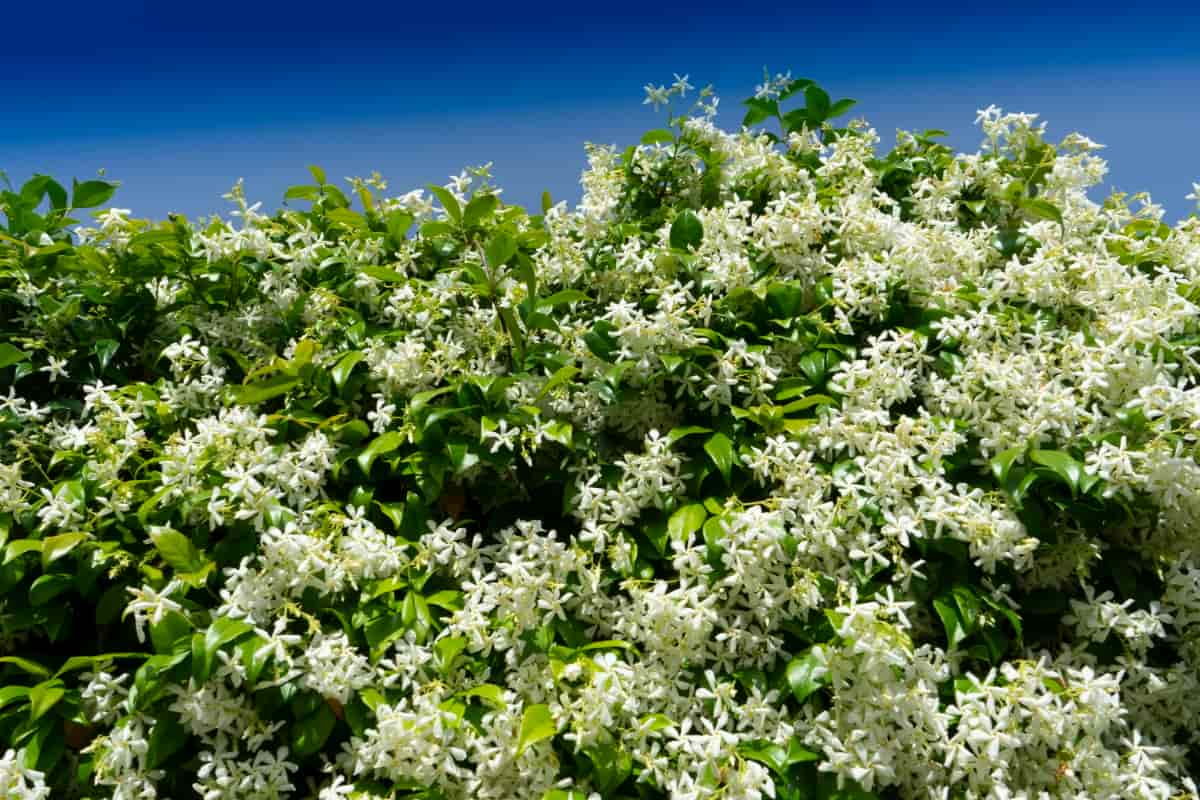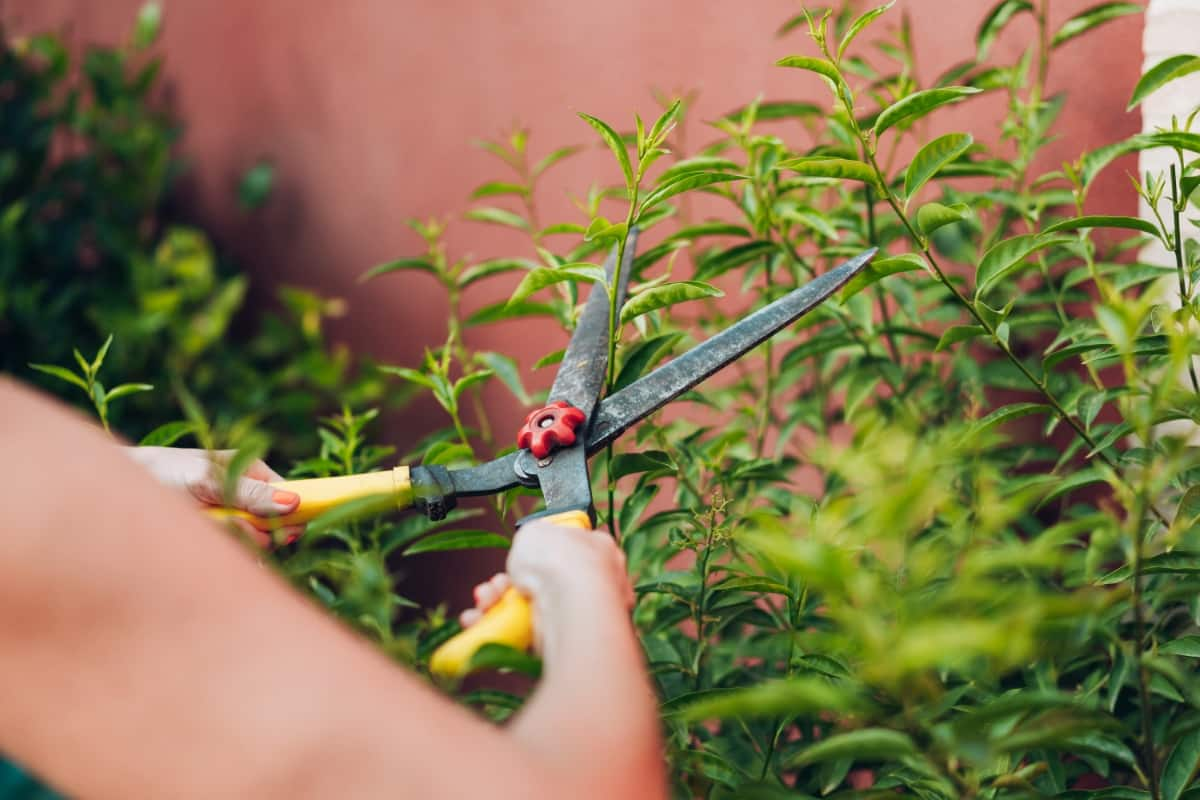Jasmine is a popular flowering plant known for its delicate white flowers and enchanting scent. Pruning is an important aspect of maintaining a healthy and bushy Jasmine plant. Regularly trimming dead branches or pinching off tips in their second year of growth can encourage branching for more blooms. Let’s check out how to make Jasmine bushy below.

Homemade Fertilizer for Jasmine Plant Growth
- Jasmine plants require proper nutrition to grow healthy and bloom beautifully. While plenty of commercial fertilizers are available, making your homemade fertilizer can be more cost-effective and eco-friendly.
- One of the best homemade fertilizers for Jasmine is coffee grounds. Used coffee grounds are rich in nitrogen, phosphorus, and potassium – essential nutrients that promote healthy growth and blooming. Sprinkle some used coffee grounds around the base of your Jasmine plant every few weeks.
- Banana peels are another homemade fertilizer, a great source of potassium, which helps with root development and flower production. Chop some banana peels into small pieces and bury them around the roots of your Jasmine plant.
- Eggshells are also a natural source of calcium, which plays a main role in cell growth and nutrient absorption. Crushed eggshells can be sprinkled onto the soil surrounding your Jasmine plant to boost calcium.
Composting Tips for Maximum Flowering in Jasmine Plants
- Composting is an excellent way to give Jasmine plants the nutrients for healthy growth.
- Add organic matter like leaves, grass clippings, and food scraps to your compost heap.
- Avoid using meat or dairy products in your compost mixture, as these can attract pests and produce unpleasant odors.
- Keep your compost pile moist by watering it occasionally but not too much, as excessive moisture can lead to anaerobic conditions that may harm beneficial microorganisms.
- Turn the compost regularly with a pitchfork or shovel to ensure proper airflow and decomposition of materials.
- Let the finished compost sit for a few weeks before applying it around the base of your Jasmine plant. This will give any harmful bacteria time to die off so that you don’t inadvertently expose your plants to them. Then, you can create nutrient-rich soil perfect for growing beautiful Jasmine plants.
How to Make Jasmine Bushy?
- It’s important to note that pinching out tips is one effective way to promote branching. This technique involves removing the tip of the stem with your fingers or pruning shears, which forces the plant to grow lateral shoots below where you cut.
- Be sure not to pinch too much at once, as this could weaken your plant or cause damage. Instead, try pinching just a small amount from each stem throughout its second year of growth for optimal results.
- Jasmine plants also benefit from regular pruning throughout their lifespan. Pruning encourages new growth by removing dead wood and promoting air circulation, which reduces disease risk in humid climates. Pruning will encourage new growth and more frequent blooming throughout the year.
- In addition to these techniques, provide your Jasmine with adequate sunlight and water for healthy growth. With proper care and attention, your Jasmine will soon become a beautiful bushy addition to any garden or home.
In case you missed it: Homemade Fertilizers to Make Money Plant Bushy and How to Grow Faster in Water and Soil

Tips to Make Jasmine Plant Growth?
- Make sure that your Jasmine plant is getting enough sunlight. Jasmine plants need at least 6 hours of sunlight daily to grow properly. So, if your plant isn’t getting enough sunlight, consider moving it to a sunnier spot or providing additional light with artificial lighting.
- Another method to increase the growth of your Jasmine plant is by fertilizing it regularly. Using phosphorus-rich fertilizers like banana peels and kitchen waste can help promote healthy growth in your Jasmine plant. However, avoid fertilizing during winter as this may lead to salt build-up in the soil.
- Pruning is important in increasing your Jasmine plant’s overall health and growth. It’s advisable to prune after the flowering season ends since cutting off new buds could limit blooming potential later on). Removing dead or diseased branches from time to time helps stimulate new growth while keeping pests away.
Is Epsom Salt Good for Jasmine Plant?
Adding Epsom salt to your Jasmine plant’s soil or as a foliar spray can enhance its green color and boost flower blooming. In addition, research has shown that Epsom salt may help promote bushier growth in plants by stimulating the production of new shoots. Too much magnesium can lead to toxicity and harm your Jasmine plant. To use Epsom salt on your Jasmine, dissolve 1 tablespoon per gallon of water and then apply as a foliar spray or pour it around the base of the plant. Use once every two weeks during active growing seasons (spring and summer), but avoid using during winter when plants are dormant.
Pruning Tips to Make Jasmine Plant Bushy
- Pruning is an essential aspect of maintaining healthy and bushy Jasmine plants. Regular pruning helps to promote new growth, remove dead or diseased wood, and keep the desired size and shape of the plant.
- It’s important first to identify any damaged or dead wood that needs to be removed.
- To encourage bushier growth in your Jasmine plant, pinch out tips during their second year of growth. This will stimulate branching and promote fuller foliage.
- Regular training would benefit Jasmine plants grown on trellises or other support structures. Tie new shoots to the structure as they grow so they don’t become tangled or break under their weight.
- It’s also important not to over-prune your Jasmine plant, leading to stunted plant growth and reduced flowering. Instead, aim for light pruning throughout the growing season rather than heavy cuts all at once.
- Moreover, pruning is also crucial for promoting bushy growth. You must regularly prune your Jasmine during winter, summer, and rainy seasons to maintain its shape and prevent overgrowth. Always use sharp shears while cutting back dead or damaged branches.
In case you missed it: Homemade Fertilizers to Make Curry Leaf Plant Bushy: How to Compost and Prune, Tips for More Branches

When to Fertilize Jasmine Plant?
Jasmine plants need regular fertilization to grow and bloom correctly. The best time to fertilize a Jasmine plant is the early spring and summer when they are actively growing. During these times, the plant has greater nutrient requirements, ensuring healthy growth. It’s essential not to over-fertilize Jasmine plants as too much fertilizer application can cause damage or even death to the plant. Providing extra nutrients in small amounts instead of one large dose is always better for your plants.
Conclusion
Jasmine is a flowering plant that belongs to the olive family. Providing the right nutrients through homemade fertilizers like coffee grounds or using kitchen waste as compost tea can help enhance growth and flowering in your Jasmine plant.
- Ultimate Guide to Ossabaw Island Hog: Breeding, Raising, Diet, and Care
- Ultimate Guide to Juliana Pig: Raising Facts, Size, Diet, Care, and Lifespan
- Raising Lleyn Sheep: Disadvantages, Price, Uses, Characteristics, and Care
- Ultimate Guide to Meishan Pig: Breed Facts, Breeding, Raising, and Care
- Ultimate Guide to Teacup Pigs: Raising, Diet, Lifespan, Cost, and Care
- Guide to Raising Poll Dorset Sheep: Facts, Profile, Characteristics, Uses, and Care
- Ultimate Guide to Bighorn Sheep: Characteristics, Diet, Lifespan, Breeding, and Lifecycle
- Ultimate Guide to Raising Katahdin Sheep: Farming Facts, Breed Profile, Uses, and Care
- Ultimate Guide to Raising Oreo Cows: Belted Galloways Farming Facts, Profile, Uses, and Care